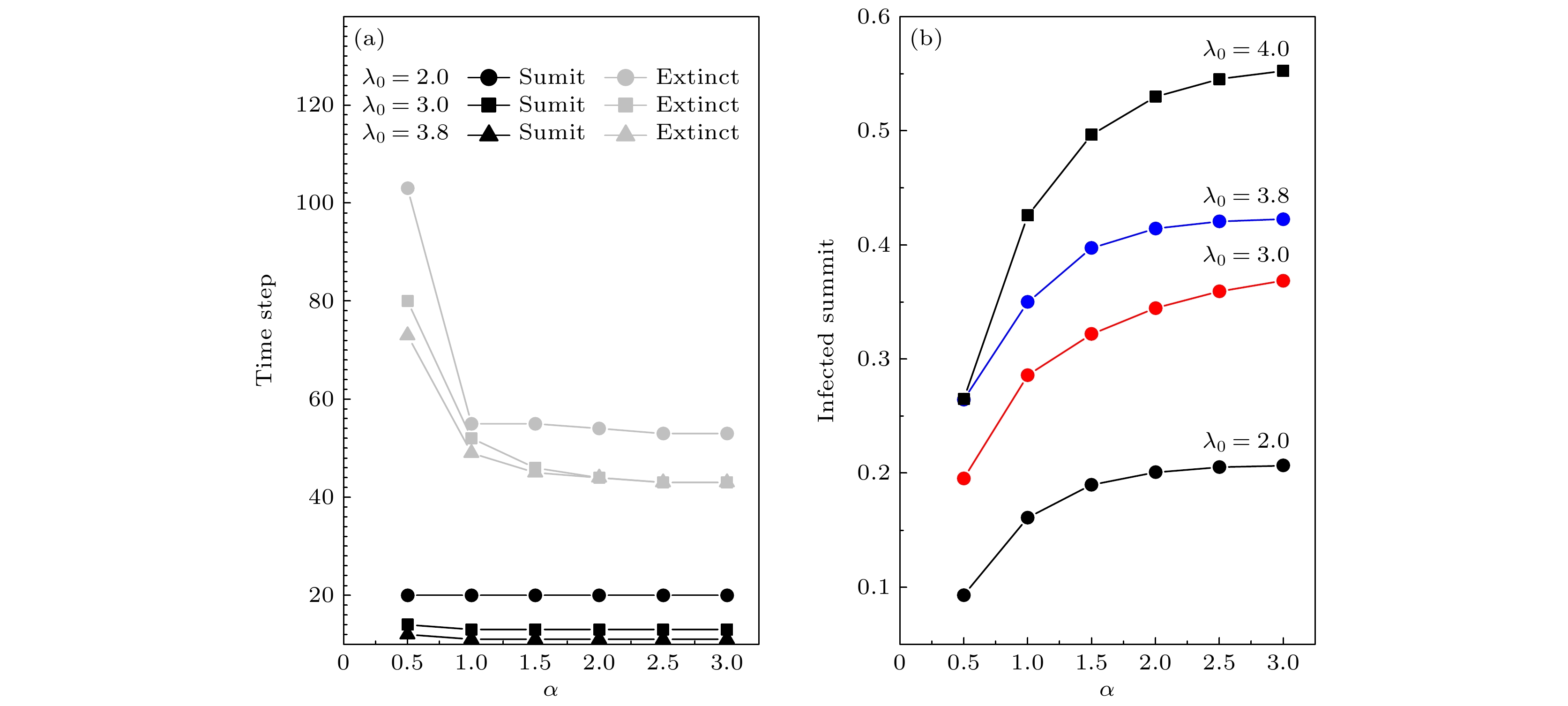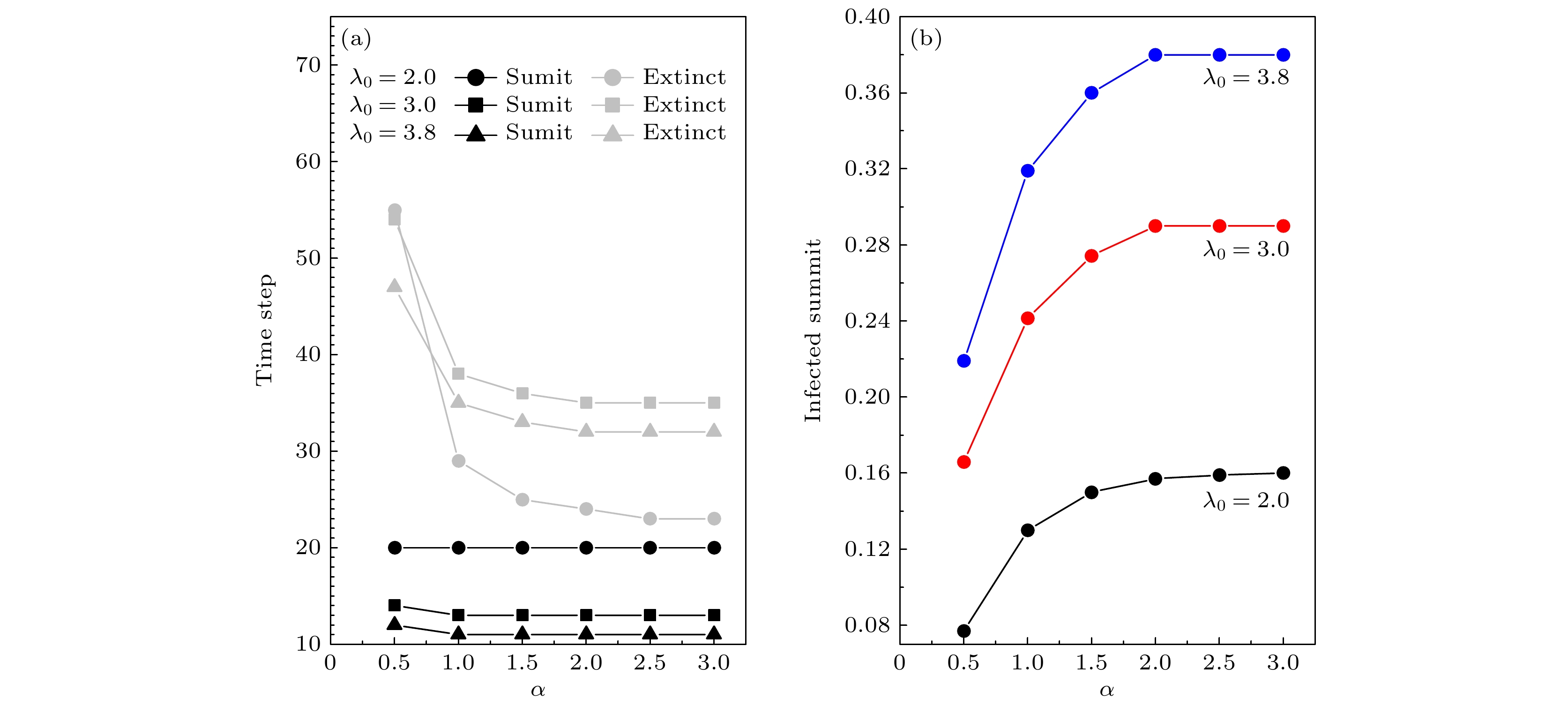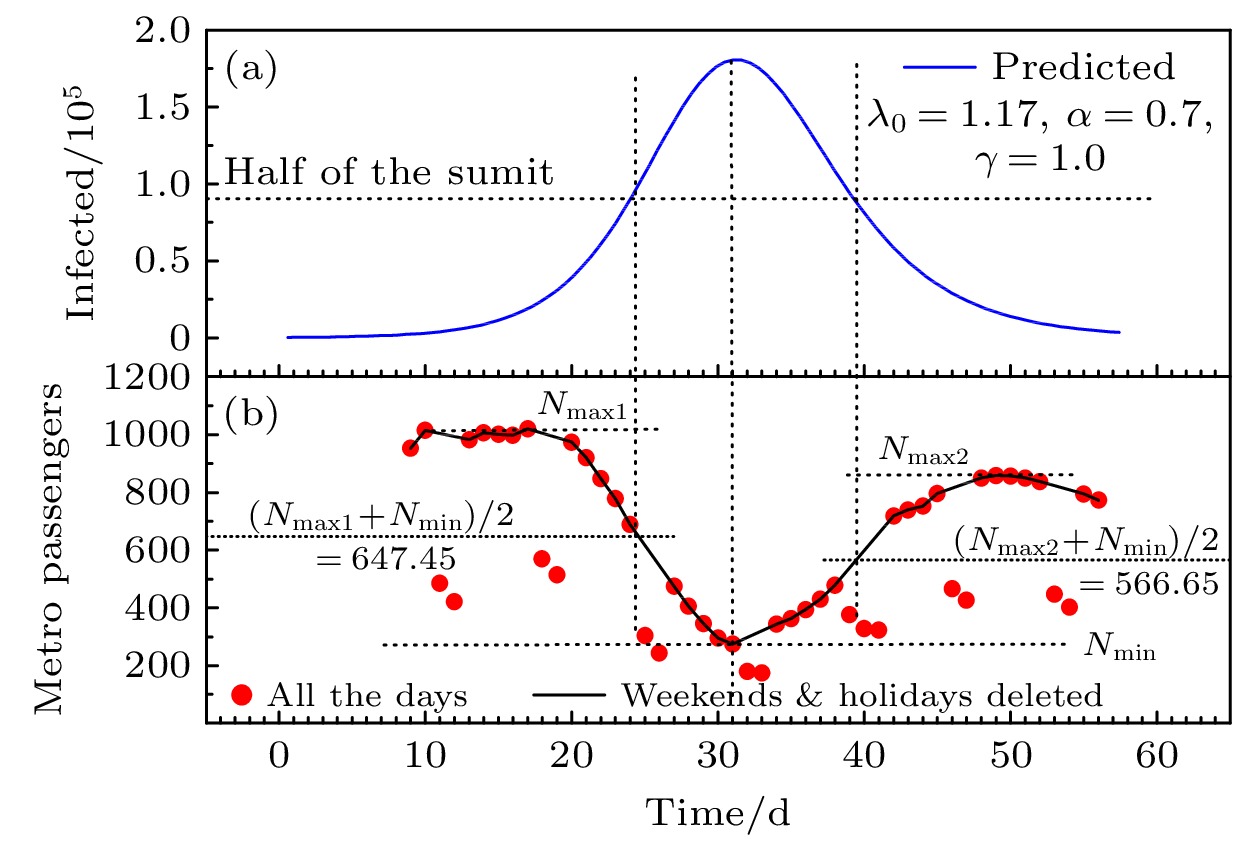-
由于新冠病毒不断变异, 在很长的时期内疫情会多次爆发, 每次有不同的特点. 对局部地区爆发的每一波疫情进行预测, 成为人们制定应对策略的关键. 在宏观层面对疫情防控措施优化, 意味着疫情演化数据的缺乏, 这给基于实证数据的疫情预测带来了特殊的困难. 考虑疫情与出行行为的相互影响, 本文提出了一个改进的虫口模型, 用以描述新冠疫情传播动力学过程, 试图利用少量疫情相关数据对局部地区爆发的某一特定疫情进行预测. 实证分析表明, 该模型可以很好地复现上海市2022年3月1日到6月28日发布的新冠病毒阳性感染者数据. 采用这一模型对上海市2022年12月以来的疫情趋势和关键节点进行了预测. 建议决策部门按照统计学抽样原则, 建立和完善疫情监测系统, 为疫情预测提供可靠的数据.Owing to the continuous variant of the COVID-19 virus, the present epidemic may persist for a long time, and each breakout displays strongly region/time-dependent characteristics. Predicting each specific burst is the basic task for the corresponding strategies. However, the refinement of prevention and control measures usually means the limitation of the existing records of the evolution of the spread, which leads to a special difficulty in making predictions. Taking into account the interdependence of people’s travel behaviors and the epidemic spreading, we propose a modified logistic model to mimic the COVID-19 epidemic spreading, in order to predict the evolutionary behaviors for a specific bursting in a megacity with limited epidemic related records. It continuously reproduced the COVID-19 infected records in Shanghai, China in the period from March 1 to June 28, 2022. From December 7, 2022 when China adopted new detailed prevention and control measures, the COVID-19 epidemic broke out nationwide, and the infected people themselves took “ibuprofen” widely to relieve the symptoms of fever. A reasonable assumption is that the total number of searches for the word “ibuprofen” is a good representation of the number of infected people. By using the number of searching for the word “ibuprofen” provided on Baidu, a famous searching platform in China, we estimate the parameters in the modified logistic model and predict subsequently the epidemic spreading behavior in Shanghai, China starting from December 1, 2022. This situation lasted for 72 days. The number of the infected people increased exponentially in the period from the beginning to the 24th day, reached a summit on the 31st day, and decreased exponentially in the period from the 38th day to the end. Within the two weeks centered at the summit, the increasing and decreasing speeds are both significantly small, but the increased number of infected people each day was significantly large. The characteristic for this prediction matches very well with that for the number of metro passengers in Shanghai. It is suggested that the relevant departments should establish a monitoring system composed of some communities, hospitals, etc. according to the sampling principle in statistics to provide reliable prediction records for researchers.
-
Keywords:
- COVID-19 /
- dynamical model /
- prediction for epidemic spreading
[1] 中华人民共和国中央人民政府国务防联防联控机制综合组 http://www.gov.cn/xinwen/2022-11/11/content_5726122.htm [2022-11-11]
The State Council’s Joint Prevention and Control Mechanism against the COVID-19 Epidemic of the Central People’s Government of the People’s Republic of China
[2] 中华人民共和国中央人民政府国务防联防联控机制综合组 http://www.gov.cn/xinwen/2022-12/07/content_5730443.htm [2022-12-07]
The State Council’s Joint Prevention and Control Mechanism against the COVID-19 Epidemic of the Central People’s Government of the People’s Republic of China
[3] Leung K, Leung G M, Wu J T 2022 MedRxiv: 2022.12.14.22283460
[4] 王聪, 严洁, 王旭, 李敏 2020 物理学报 69 080701
 Google Scholar
Google Scholar
Wang C, Yan J, Wang X, Li M 2020 Acta Phys. Sin. 69 080701
 Google Scholar
Google Scholar
[5] 曹文静, 刘小菲, 韩卓, 冯鑫, 张琳, 刘肖凡, 许小可, 吴晔 2020 物理学报 69 090203
 Google Scholar
Google Scholar
Cao W J, Liu X F, Han Z, Feng X, Zhang L, Liu X F, Xu X K, Wu Y 2020 Acta Phys. Sin. 69 090203
 Google Scholar
Google Scholar
[6] 戴碧涛, 谭索怡, 陈洒然, 蔡梦思, 秦烁, 吕欣 2021 物理学报 70 068903
 Google Scholar
Google Scholar
Dai B T, Tan S Y, Chen S R, Cai M S, Qin S, Lu X 2021 Acta Phys. Sin. 70 068903
 Google Scholar
Google Scholar
[7] Necesito I V, Velasco J M S, Jung J, Bae Y H, Lee J H, Kim S J, Kim H S 2022 PLoS One 17 e0268023
 Google Scholar
Google Scholar
[8] Ghosal S, Sengupta S, Majumder M, Sinha B 2020 Diabetes Metab. Syndr. 14 311
 Google Scholar
Google Scholar
[9] Hoertel B, Blachier M, Blanco C, Olfson M, Massetti M, Rico M S, Limosin F, Leleu H 2020 Nat. Med. 26 1417
 Google Scholar
Google Scholar
[10] Zhao Z R, Chen A, Hou W, Graham J M, Li H F, Richman P S, Thode H C, Singer A J, Duong T Q 2020 PLoS One 15 e0236618
 Google Scholar
Google Scholar
[11] Hernandez-Matamoros A, Fujita H, Hayashi T, Perez-Meana H 2020 APPL Soft Comput. 96 106610
 Google Scholar
Google Scholar
[12] Alazab M, Awajan A, Mesleh A, Abraham A, Jatana V, Alhyari S 2020 INT J. Comput. Inf. Syst. Ind. Manag. Appl. 12 168
[13] Parbat D, Chakraborty M 2020 Chaos, Solitons Fractals 138 109942
 Google Scholar
Google Scholar
[14] Zhao Y F, Shou M H, Wang Z X 2020 Int. J. Environ. Res. Public Health 17 4582
 Google Scholar
Google Scholar
[15] Siwiak M, Szczesny P, Siwiak M 2020 PeerJ 8 e9548
 Google Scholar
Google Scholar
[16] Bhandari S, Tak A, Gupta J, Patel B, Shukla J, Shaktawat A S, Singhal S, Saini A, Kakkar S, Dube A, Dia S, Dia M, Wehner T C 2020 Research Square https://doi.org/10.21203/rs.3.rs-40385/v1
[17] Yang Z F, Zeng Z Q, Wang K, Wong S S, Liang W H, Zanin M, Liu P, Cao X D, Gao Z Q, Mai Z T, Liang J Y, Liu X Q, Li S Y, Li Y M, Ye F, Guan W J, Yang Y F, Li F, Luo S M, Xie Y Q, Liu B, Wang Z L, Zhang S B, Wang Y N, Zhong N S, He J X 2020 J. Throac. Dis. 12 165
 Google Scholar
Google Scholar
[18] Chatterjee K, Chatterjee K, Kumar A, Shankar S 2020 Med. J. Armed Forces India 76 147
 Google Scholar
Google Scholar
[19] Kissler S M, Tedijanto C, Goldstein E, Grad Y H, Lipsitch M 2020 Science 368 860
 Google Scholar
Google Scholar
[20] Zhao Y J, Huang J P, Zhang L, Lian X B, Wang D F 2022 The Innovation 3 100240
[21] 孙皓宸, 刘肖凡, 许小可, 吴晔 2020 物理学报 69 240201
 Google Scholar
Google Scholar
Sun H C, Liu X F, Xu X K, Wu Y 2020 Acta Phys. Sin. 69 240201
 Google Scholar
Google Scholar
[22] Yan L, Zhang H T, Goncalves J, Xiao Y, Wang M L, Guo Y Q, Sun C, Tang X C, Jing L, Zhang M Y, Huang X, Xiao Y, Cao H S, Chen Y Y, Ren T X, Wang F, Xiao Y R, Huang S F, Tan X, Huang N N, Jiao B, Cheng C, Zhang Y, Luo A L, Mombaerts L, Jin J Y, Cao Z G, Li S S, Xu H, Yuan Y 2020 Nat. Mach. Intell. 2 283
 Google Scholar
Google Scholar
[23] Hu Z X, Ge Q Y, Li S D, Jin L, Xiong M M 2020 arXiv: 2002.07112 v2[q-bio.OT]
[24] Tomar A, Gupta N 2020 Sci. Total Environ. 728 138762
 Google Scholar
Google Scholar
[25] Chimmula V K R, Zhang L 2020 Chaos, Solitons Fractals 135 109864
 Google Scholar
Google Scholar
[26] Ardabili S, Mosavi A, Ghamisi P, Ferdinand F, Varkonyi-Koczy A, Reuter U, Rabczuk T, Atkinson P 2020 Algorithms 13 249
 Google Scholar
Google Scholar
[27] Sujath R, Chatterjee J M, Hassanien A E 2020 Stoch. Environ. Res. Risk. Assess 34 959
 Google Scholar
Google Scholar
[28] Arora P, Kumar H, Panigrahi B K 2020 Chaos, Solitons Fractals 139 110017
 Google Scholar
Google Scholar
[29] Fernandez A, Obiechina N, Koh J, Hong A, Nandi A, Reynolds T M 2021 Int. J. Clin. Pract. 75 e13974
 Google Scholar
Google Scholar
[30] Muhammad L J, Islam M M, Usman S S, Ayon S S 2020 SN Comput. Sci. 1 206
 Google Scholar
Google Scholar
[31] https://baijiahao.baidu.com/s?id=1752161828062869006&wfr=spider&for=pc [2022-12-20]
[32] [33] -
图 5 上海阳性感染者预测曲线与地铁乘客数量曲线比较 (a)上海2022年12月到2023年2月新冠阳性每日新增预测; (b)地铁乘客人数, 曲线向右移动了8天
Fig. 5. Comparison of the prediction of infected number per day with the number of metro passengers in Shanghai China: (a) Prediction of COVID-19 virus infected numbers in the duration from Dec. 2022 to Feb. 2023 in Shanghai, China; (b) metro passenger numbers, where the time has been shifted rightly 8 days
-
[1] 中华人民共和国中央人民政府国务防联防联控机制综合组 http://www.gov.cn/xinwen/2022-11/11/content_5726122.htm [2022-11-11]
The State Council’s Joint Prevention and Control Mechanism against the COVID-19 Epidemic of the Central People’s Government of the People’s Republic of China
[2] 中华人民共和国中央人民政府国务防联防联控机制综合组 http://www.gov.cn/xinwen/2022-12/07/content_5730443.htm [2022-12-07]
The State Council’s Joint Prevention and Control Mechanism against the COVID-19 Epidemic of the Central People’s Government of the People’s Republic of China
[3] Leung K, Leung G M, Wu J T 2022 MedRxiv: 2022.12.14.22283460
[4] 王聪, 严洁, 王旭, 李敏 2020 物理学报 69 080701
 Google Scholar
Google Scholar
Wang C, Yan J, Wang X, Li M 2020 Acta Phys. Sin. 69 080701
 Google Scholar
Google Scholar
[5] 曹文静, 刘小菲, 韩卓, 冯鑫, 张琳, 刘肖凡, 许小可, 吴晔 2020 物理学报 69 090203
 Google Scholar
Google Scholar
Cao W J, Liu X F, Han Z, Feng X, Zhang L, Liu X F, Xu X K, Wu Y 2020 Acta Phys. Sin. 69 090203
 Google Scholar
Google Scholar
[6] 戴碧涛, 谭索怡, 陈洒然, 蔡梦思, 秦烁, 吕欣 2021 物理学报 70 068903
 Google Scholar
Google Scholar
Dai B T, Tan S Y, Chen S R, Cai M S, Qin S, Lu X 2021 Acta Phys. Sin. 70 068903
 Google Scholar
Google Scholar
[7] Necesito I V, Velasco J M S, Jung J, Bae Y H, Lee J H, Kim S J, Kim H S 2022 PLoS One 17 e0268023
 Google Scholar
Google Scholar
[8] Ghosal S, Sengupta S, Majumder M, Sinha B 2020 Diabetes Metab. Syndr. 14 311
 Google Scholar
Google Scholar
[9] Hoertel B, Blachier M, Blanco C, Olfson M, Massetti M, Rico M S, Limosin F, Leleu H 2020 Nat. Med. 26 1417
 Google Scholar
Google Scholar
[10] Zhao Z R, Chen A, Hou W, Graham J M, Li H F, Richman P S, Thode H C, Singer A J, Duong T Q 2020 PLoS One 15 e0236618
 Google Scholar
Google Scholar
[11] Hernandez-Matamoros A, Fujita H, Hayashi T, Perez-Meana H 2020 APPL Soft Comput. 96 106610
 Google Scholar
Google Scholar
[12] Alazab M, Awajan A, Mesleh A, Abraham A, Jatana V, Alhyari S 2020 INT J. Comput. Inf. Syst. Ind. Manag. Appl. 12 168
[13] Parbat D, Chakraborty M 2020 Chaos, Solitons Fractals 138 109942
 Google Scholar
Google Scholar
[14] Zhao Y F, Shou M H, Wang Z X 2020 Int. J. Environ. Res. Public Health 17 4582
 Google Scholar
Google Scholar
[15] Siwiak M, Szczesny P, Siwiak M 2020 PeerJ 8 e9548
 Google Scholar
Google Scholar
[16] Bhandari S, Tak A, Gupta J, Patel B, Shukla J, Shaktawat A S, Singhal S, Saini A, Kakkar S, Dube A, Dia S, Dia M, Wehner T C 2020 Research Square https://doi.org/10.21203/rs.3.rs-40385/v1
[17] Yang Z F, Zeng Z Q, Wang K, Wong S S, Liang W H, Zanin M, Liu P, Cao X D, Gao Z Q, Mai Z T, Liang J Y, Liu X Q, Li S Y, Li Y M, Ye F, Guan W J, Yang Y F, Li F, Luo S M, Xie Y Q, Liu B, Wang Z L, Zhang S B, Wang Y N, Zhong N S, He J X 2020 J. Throac. Dis. 12 165
 Google Scholar
Google Scholar
[18] Chatterjee K, Chatterjee K, Kumar A, Shankar S 2020 Med. J. Armed Forces India 76 147
 Google Scholar
Google Scholar
[19] Kissler S M, Tedijanto C, Goldstein E, Grad Y H, Lipsitch M 2020 Science 368 860
 Google Scholar
Google Scholar
[20] Zhao Y J, Huang J P, Zhang L, Lian X B, Wang D F 2022 The Innovation 3 100240
[21] 孙皓宸, 刘肖凡, 许小可, 吴晔 2020 物理学报 69 240201
 Google Scholar
Google Scholar
Sun H C, Liu X F, Xu X K, Wu Y 2020 Acta Phys. Sin. 69 240201
 Google Scholar
Google Scholar
[22] Yan L, Zhang H T, Goncalves J, Xiao Y, Wang M L, Guo Y Q, Sun C, Tang X C, Jing L, Zhang M Y, Huang X, Xiao Y, Cao H S, Chen Y Y, Ren T X, Wang F, Xiao Y R, Huang S F, Tan X, Huang N N, Jiao B, Cheng C, Zhang Y, Luo A L, Mombaerts L, Jin J Y, Cao Z G, Li S S, Xu H, Yuan Y 2020 Nat. Mach. Intell. 2 283
 Google Scholar
Google Scholar
[23] Hu Z X, Ge Q Y, Li S D, Jin L, Xiong M M 2020 arXiv: 2002.07112 v2[q-bio.OT]
[24] Tomar A, Gupta N 2020 Sci. Total Environ. 728 138762
 Google Scholar
Google Scholar
[25] Chimmula V K R, Zhang L 2020 Chaos, Solitons Fractals 135 109864
 Google Scholar
Google Scholar
[26] Ardabili S, Mosavi A, Ghamisi P, Ferdinand F, Varkonyi-Koczy A, Reuter U, Rabczuk T, Atkinson P 2020 Algorithms 13 249
 Google Scholar
Google Scholar
[27] Sujath R, Chatterjee J M, Hassanien A E 2020 Stoch. Environ. Res. Risk. Assess 34 959
 Google Scholar
Google Scholar
[28] Arora P, Kumar H, Panigrahi B K 2020 Chaos, Solitons Fractals 139 110017
 Google Scholar
Google Scholar
[29] Fernandez A, Obiechina N, Koh J, Hong A, Nandi A, Reynolds T M 2021 Int. J. Clin. Pract. 75 e13974
 Google Scholar
Google Scholar
[30] Muhammad L J, Islam M M, Usman S S, Ayon S S 2020 SN Comput. Sci. 1 206
 Google Scholar
Google Scholar
[31] https://baijiahao.baidu.com/s?id=1752161828062869006&wfr=spider&for=pc [2022-12-20]
[32] [33]
计量
- 文章访问数: 6300
- PDF下载量: 122
- 被引次数: 0














 下载:
下载:




